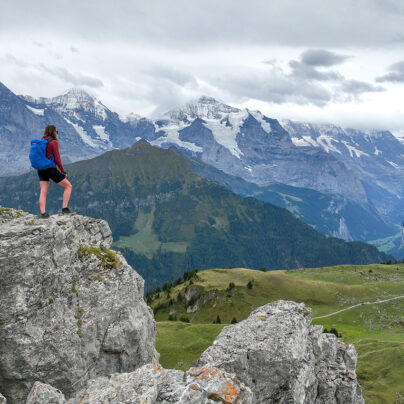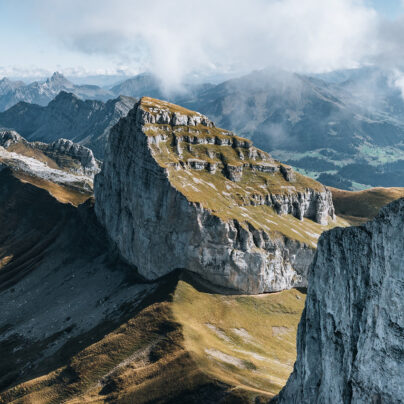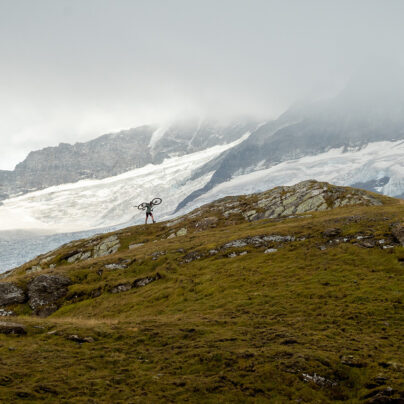Shades of Alpine White
A Week in the Bernese Oberland
Written by Jess Clark // Photography by Aaron Rolph // Film by Luke Jarmey
Produced in partnership with Switzerland Tourism
A palpable thrill filled the crisp Alpine air as I stepped off the train in Wengen. Although dark, I could already sense the magnitude of the peaks around me.
Day One
I had never skied in the Jungfrau Region, nor seen the famous Eiger North Face. Wengen sits at 1,274m, and, like several resorts in Switzerland, the village is car free. The only sounds were the icy crunch beneath my feet, the soft rustling of snow-laden branches, and the occasional laughter of fellow tourists.



Normally a heavy sleeper, I woke naturally – and with a mix of excitement and anticipation. I jumped out of bed and onto the balcony to look out over the valley, the landscape still bathed in a warm pink glow. A cold wind sent me retreating into my room, and I eagerly donned several layers of merino and Gore-Tex. Then, with childlike enthusiasm, I devoured a rushed buffet breakfast of fresh fruit, pancakes, and local cheeses. The hotel boasts door-to-door access, and I skied straight down the nursery slope to the doors of the cable car, ready for opening.
I soon arrived at Männlichen. This watershed between the two Lütschinen valleys perches at the foot of the Eiger, Mönch, and Jungfrau mountains. The towering Eiger North Face immediately commanded all of my attention. How could it not? First climbed in 1938, the Eigernordwand is the biggest north face in the Alps – and still considered one of its hardest and most dangerous ascents. I became fascinated by the mountain recently after a friend, Tim Howell, completed his project BASE jumping from the six great north faces of the Alps.
My day was to be more humble, exploring within the confines of the resort. The surrounding ski area boasts over 200km of groomed pistes and is home to the world-famous Lauberhorn downhill race. Living in Chamonix I have grown accustomed to busy slopes and long queues, so I rarely make the time to enjoy piste skiing. It felt liberating to charge around the resort, lapping run after run, all connected by a state-of-the-art lift system. The weather was perfect – a crisp –5°C to keep the pistes firm – with clear bluebird skies above. After lunch I took the opportunity to explore some slack country. A few areas remained untouched several days after the last snowfall. It was a day of pure type-one fun, only made better by skiing back to the village for a relaxed evening in the hotel.



Day TWO
After an early start I skied down to Grindelwald to meet my guide for the day: a small, wiry, older gentleman with a cheeky smile and infectious enthusiasm. Willy grew up in Grindelwald and has been guiding in the area for almost 40 years. We became acquainted on a series of lifts before reaching the top of the resort and beginning our human-powered ascent. Dense cloud was rising from the valley and we were soon enveloped in a milky fog. As we powered forward the clouds rolled in and out, obscuring our view of the summits above, until soon enough we were baking in the sun, looking up toward our objective and down at a thick blanket of cloud covering the valley below.
Although I could feel the sun warm on my back, a bitterly cold wind was picking up, burning my cheeks. The wind had already scoured the summit, leaving a hard, icy ridge. I swaddled myself in as many layers as possible, still shivering, before making a cumbersome transition from skis to crampons. Firm snow allowed me to move quickly – and within minutes my lungs were burning from a mix of cold air and physical exertion. Prominent 4,000m summits broke like cresting waves above a vast sea of Alpine peaks. Once at the top I turned back to see the Eiger in all his glory: the centrepiece of one of the most breathtaking views I’ve had the pleasure of experiencing. Alone on the summit, I took a moment to soak in the view as Willy patiently waited below, enjoying a sandwich his wife had prepared the night before. Living in a valley it is not often I get to see such broad horizons!
After clicking into my skis, I made a series of precise turns along the ridge before opening up on the less exposed terrain below. Conditions were certainly better suited to bootpacking than skiing, but what the ski down lacked in good snow was surely compensated by the incredible views and seemingly endless descent.
As we cruised back towards the resort, the light grew warm. A soft orange blushed across the snow. Willy insisted on a well-earned stop at his friend’s buvette, where I enjoyed a delicious hot chocolate hiding under a mountain of whipped cream. As most days in the mountains are, sharing the day with Willy had been a pleasure. But this was different. Travelling with a guide in unfamiliar terrain removed a lot of the responsibility and decision-making I have grown used to. It was a real luxury that I would recommend to anyone.



The experience was both peaceful and invigorating, a chance to connect with nature in its quietest and most awe-inspiring form.
Day Three
After a long day ski touring, I appreciated the leisurely start. I woke late and enjoyed a leisurely brunch before checking out and leaving the resort. Then I took the train down the mountain from Wengen to Interlaken – an Alpine resort between the turquoise waters of Lake Thun and Lake Brienz. It felt like a familiar mix of the two places I now call home: Chamonix the French high-Alpine mecca, and Varese, a city in Northern Italy surrounded by lakes.
My goal for the day was to experience the lakes from a bird’s eye view – and powered by the wind. During Covid, I helped on a research project documenting glacier recession in the Chamonix valley. In order to avoid contributing to the plight of our glaciers, the project was carbon neutral, travelling up the mountain on skis and down by wing. I was delighted to have the opportunity to take to the sky again.
As I harnessed up and listened intently to the pilot’s instructions, a blend of excitement and edginess coursed through me. I started running – and, with a rush of wind, we were airborne, the ground quickly receding below us. The sensation of flight was surreal. As if I were a part of the sky itself. Views of Interlaken’s verdant valleys and the surrounding snow-capped peaks left me in awe, but were quickly interrupted by a performance of daredevil acrobatics – a tandem dance with the wind, a symphony of emotions playing out against the backdrop of Switzerland’s natural splendour (and all while trying to keep my regrettably heavy breakfast down). Suddenly the tiny buildings below were growing larger until I could make out details, then cars and pedestrians. The roller-coaster ride had come to an end.
We made a final loop before gracefully arcing back towards the landing field. Being tall, my feet touched the floor first, and I ran a few frantic steps to avoid a fall. With my heart still racing, the canopy collapsed around us, and I looked up the mountain. Had we really taken off from up there only minutes before?
Next on the itinerary was winter kayaking, which offered another unique perspective of the valley. Sealed into my drysuit, I looked ready to take a walk on the Moon as I launched my kayak onto the glassy lake. As I paddled gently, I marvelled at how the world seemed to hold its breath in anticipation of the changing seasons. Down by the lake it already felt like spring – snow was melting from the lofty peaks above, and greenery had begun to burst into life on the shore. Crisp, refreshing air caressed my cheek. The water’s surface mirrored the hushed surroundings, reflecting the muted colours of the valley.
In a previous life I had been a rower, accustomed to cold early morning training sessions on the Avon. Weirdly, this was my first time back in a boat since those days. It felt new and exciting to be paddling across an Alpine lake – but at the same time comforting and familiar. Since my next expedition would be in Arctic Norway, a skirafting adventure using packrafts to access remote skiing objectives, I was particularly grateful for this experience. I already knew that my kayaking fitness (or lack of it) would be my main struggle on the trip. One of the guides kindly helped me to improve my stroke, and I quickly learnt that paddling efficiency and a strong core are essential.
Winter kayaking proved to be a serene yet thrilling adventure, a harmonious blend of nature’s tranquillity and the exhilaration of exploration in colder climes. After a few hours, I clumsily bundled out of the water, arms aching but still bone dry. On the drive back to town I found myself googling white-water kayaking and other activities far beyond my newly acquired skills.



Day Four
For the final day I took the opportunity to sample some of Interlaken’s more accessible adventures. My guide picked me up from the shores of the lake and we headed up the mountain on a narrow winding track, barely accessible in winter. The road meandered through quintessential Swiss hamlets: clusters of romantic wooden chalets, a scene from my storybook-loving childhood mind’s eye. My guide and I quickly bonded over a love of the outdoors and a dispassion for anything office based. As a ski tourer I had never felt the urge to go snowshoeing, but I was interested to try something new and make the most of another beautiful day in the Swiss Alps.
I strapped into a set of racquets and found myself embracing a rhythmic stride that allowed me to navigate the snowy trail with ease. I have long been a great supporter of getting more people moving and enjoying the outdoors. Having studied public health and environmental science, I know the many benefits of time spent in nature – and it soon became obvious that snowshoeing is a fantastic vehicle to enjoy the mountains in winter. It is more affordable, less technical, and safer than skiing, but allows you to experience the same epic Alpine landscapes and views. As I ventured further into the forest I could see how snowshoeing would open up a whole new world of exploration for many. The experience was both peaceful and invigorating, a chance to connect with nature in its quietest and most awe-inspiring form.
To finish the trip we headed down to Lake Brienz to enjoy a relaxing evening in a floating jacuzzi, or Hot Tug. Joined by the lovely crew that made this trip possible, we set off from the docks. The water was piping hot – a fantastic contrast to the cold evening air and water. After a short tour and a few beers, we took to jumping into the freezing lake before scampering back to the comforts of our floating spa.
As I floated with the others in the Hot Tug, I reflected on a fantastic week exploring the Bernese Oberland, its impressive mountains and turquoise lakes. There is something truly magical about the Swiss Alps. I can’t wait to come back. Perhaps one day to climb the fateful Eiger North Face!
Written by Jess Clark // @jess.k.clark
Photography by Aaron Rolph // @aaronrolph
Film by Luke Jarmey // @lukejarmey
Produced in partnership with Switzerland Tourism, Interlaken and The Jungfrau Region









